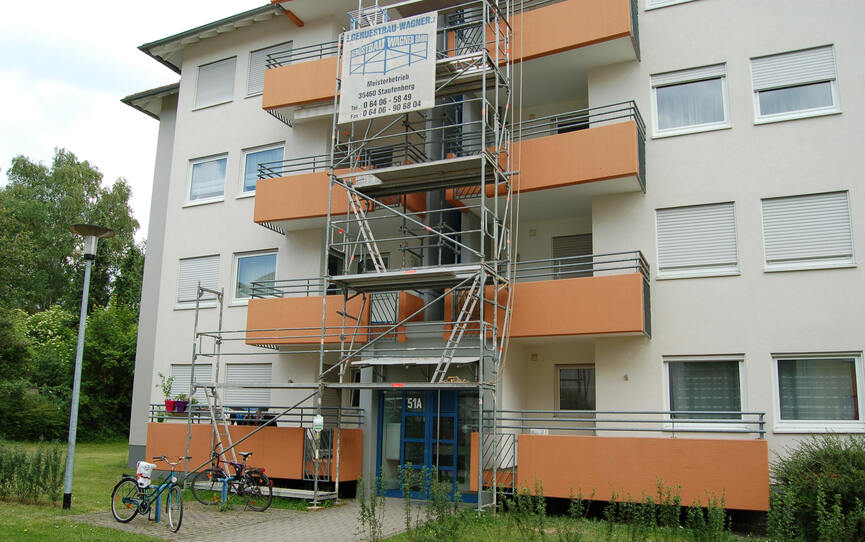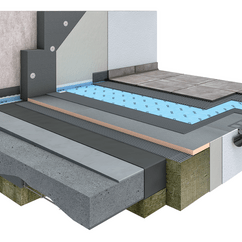PCI system structure enables thin-layer energy-efficient refurbishment of balconies, loggias and access balconies
Efficient thermal insulation even in refurbishment projects thanks to particularly low installation height
19.02.2024

PCI Augsburg GmbH presents a new system structure for the refurbishment of balconies, loggias and access balconies which, thanks to its particularly low installation height, enables simple and reliable energy upgrading of these areas. The new PCI system structure complies with all guidelines and requirements for condensation-free thermal bridge design.
Refurbishing balconies, loggias and access balconies with a tiled or natural stone covering allows the building fabric to be used for longer and extends the living space. Renovating these areas also protects the structural part and increases the value of the property. Last but not least, thermal refurbishment saves heating costs and reduces CO2 emissions.
However, carrying out an energy-efficient renovation of balconies, loggias and access balconies is challenging and cannot be accomplished using conventional methods. On the one hand, continuous floor slabs which are often found in older properties represent a thermal bridge, and on the other hand, the construction height is an obstacle. The available construction height is not sufficient for a uniform thermal insulation of the facade and balcony or terrace. The construction with insulation boards for facades plus screed requires a construction height of approx. 25 cm. With such a construction height, it would not be possible for the users of the property to step from the inside to the outside at ground level.
However, the new PCI system structure for the renovation of balconies, loggias and terraces enables thermal insulation that is only 5 cm thin. This is achieved with the PCI PowerBoard rigid foam support elements which combine the functions of thermal insulation and screed. The coating of these boards consists of special mortar with glass fiber fabric. The low installation height allows the building envelope and balcony or loggia to be insulated as a whole thus avoiding thermal bridges and reducing energy requirements.
The other products in the PCI system structure include a leveling mortar (PCI Polycret 50), special waterproofing tape (PCI Pecitape) and optionally a reactive waterproofing layer (PCI Barraseal Turbo). This is completed by the PCI Pecilastic waterproofing membrane and a PCI tile adhesive (PCI Flexmörtel Premium, PCI Nanorapid or PCI Durapox NT) as well as the appropriate joint grout (PCI Nanofug Premium or PCI Durapox Premium).
If the thermal refurbishment is to be carried out in combination with an additional waterproofing membrane made of a mineral waterproofing slurry, PCI Barraseal Turbo reactive waterproofing is used. The composite waterproofing (AiV-B) is made from the waterproofing membrane PCI Pecilastic. In this way, it is possible to achieve an environmentally friendly, ecological moisture protection.
The calculation of the thermal insulation with the 5 cm thin PCI PowerBoard insulation board was carried out by a sworn and court-certified expert (Clemens Heinricher, TBI, Villach, engineering office for interior architecture and interior design). The expert confirms that the new PCI system structure for the renovation of balconies, loggias and access balconies complies with all guidelines and requirements for a condensation-free design method to reduce thermal bridges.
PCI Augsburg GmbH is one of the leading manufacturers of construction chemical products in Germany. Innovative, high-quality and sustainable products make the company a pioneer in the industry. The intelligent product systems in which selected individual products are reasonably combined with each other offer real added value for customers.
"We are a system provider of construction chemical products with over 70 years of expertise. Our complete systems are optimally coordinated with each other which guarantees our customers reliability in application," explains Stephan Tschernek, Head of Marketing PCI Group. "The new PCI system structure for the renovation of balconies, loggias and terraces is convincing because it also enables energy-efficient renovation of these areas. This saves heating costs, reduces CO2 emissions and increases the value of the property."
However, carrying out an energy-efficient renovation of balconies, loggias and access balconies is challenging and cannot be accomplished using conventional methods. On the one hand, continuous floor slabs which are often found in older properties represent a thermal bridge, and on the other hand, the construction height is an obstacle. The available construction height is not sufficient for a uniform thermal insulation of the facade and balcony or terrace. The construction with insulation boards for facades plus screed requires a construction height of approx. 25 cm. With such a construction height, it would not be possible for the users of the property to step from the inside to the outside at ground level.
However, the new PCI system structure for the renovation of balconies, loggias and terraces enables thermal insulation that is only 5 cm thin. This is achieved with the PCI PowerBoard rigid foam support elements which combine the functions of thermal insulation and screed. The coating of these boards consists of special mortar with glass fiber fabric. The low installation height allows the building envelope and balcony or loggia to be insulated as a whole thus avoiding thermal bridges and reducing energy requirements.
The other products in the PCI system structure include a leveling mortar (PCI Polycret 50), special waterproofing tape (PCI Pecitape) and optionally a reactive waterproofing layer (PCI Barraseal Turbo). This is completed by the PCI Pecilastic waterproofing membrane and a PCI tile adhesive (PCI Flexmörtel Premium, PCI Nanorapid or PCI Durapox NT) as well as the appropriate joint grout (PCI Nanofug Premium or PCI Durapox Premium).
If the thermal refurbishment is to be carried out in combination with an additional waterproofing membrane made of a mineral waterproofing slurry, PCI Barraseal Turbo reactive waterproofing is used. The composite waterproofing (AiV-B) is made from the waterproofing membrane PCI Pecilastic. In this way, it is possible to achieve an environmentally friendly, ecological moisture protection.
The calculation of the thermal insulation with the 5 cm thin PCI PowerBoard insulation board was carried out by a sworn and court-certified expert (Clemens Heinricher, TBI, Villach, engineering office for interior architecture and interior design). The expert confirms that the new PCI system structure for the renovation of balconies, loggias and access balconies complies with all guidelines and requirements for a condensation-free design method to reduce thermal bridges.
PCI Augsburg GmbH is one of the leading manufacturers of construction chemical products in Germany. Innovative, high-quality and sustainable products make the company a pioneer in the industry. The intelligent product systems in which selected individual products are reasonably combined with each other offer real added value for customers.
"We are a system provider of construction chemical products with over 70 years of expertise. Our complete systems are optimally coordinated with each other which guarantees our customers reliability in application," explains Stephan Tschernek, Head of Marketing PCI Group. "The new PCI system structure for the renovation of balconies, loggias and terraces is convincing because it also enables energy-efficient renovation of these areas. This saves heating costs, reduces CO2 emissions and increases the value of the property."
Downloads
-
Press release

